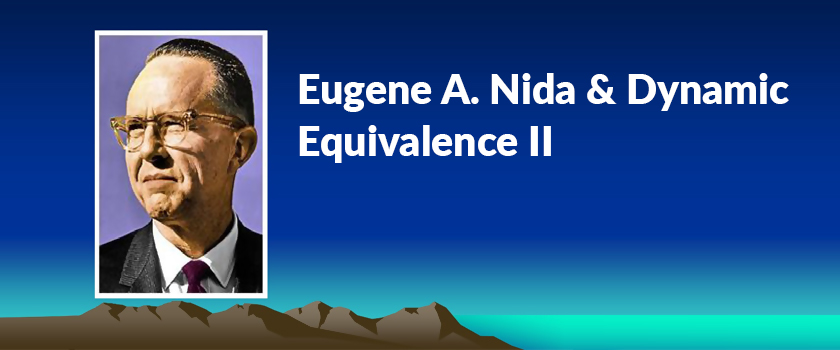Almost all Nida works are on language and translation scholarship. He told the New York Times in 1955 that the word was not a literal translation but a reflection of culture. Hence “you can’t translate without cultural context” as he stated. He knew more than eight languages and traveled the world to find local speakers to help translate the Bible. In addition to his contribution to the Bible translation, the other most impressive one for translatology could be his Dynamic Equivalence theory.
It is a translation standard set by Nida for transforming source language to target language, which is in contrast with formal-equivalence translations others are oriented at. In his book Toward a Science of Translating (1964), he introduced the term “dynamic equivalence” for the first time. The following are the views for this term quoted from his book Toward a Science of Translating.
Since “there are, properly speaking, no such things as identical equivalents” (Belloc, 1931a and b, p. 37), one must in translating seek to find the closest possible equivalent. However, there are fundamentally two different types of equivalence: one which may be called formal and another which is primarily dynamic. … a translation which attempts to produce a dynamic rather than a formal equivalence is based upon “the principle of equivalent effect” (Rieu and Phillips, 1954).
As to there is no “identical equivalents”, I also saw similar comment from other translation master. Translation should be an ever going research we should never stop but keep pursuing the better.
In such a translation one is not so concerned with matching the receptor-language message with the source-language message, but with the dynamic relationship (mentioned in Chapter 7), that the relationship between receptor and message should be substantially the same as that which existed between the original receptors and the message.
A translation of dynamic equivalence aims at complete naturalness of expression, and tries to relate the receptor to modes of behavior relevant within the context of his own culture; it does not insist that he understand the cultural patterns of the source-language context in order to comprehend the message.
The above paragraph might be the best explanation of function equivalence of a language. In my opinion, a language is a code made by certain human being group with the purpose of communication, like telling somebody something or to do something. It has certain impact upon listeners or readers. Like a novel, whether an author is telling a story or not, it mostly contains a theme, to raise a kind of feeling of readers and so on. Readers’ feeling is a response to the novel. Hence, the translation version, while the symbols convey connotation might be various, should also have the same effect to target readers, even if they belong to a totally different culture context.
Of course, there are varying degrees of such dynamic-equivalence translations. One of the modern English translations which, perhaps more than any other, seeks for equivalent effect is J.B. Phillips’ rendering of the New Testament. In Romans 16:16 he quite naturally translates “greet one another with a holy kiss” as “give one another a hearty handshake all around.” … since a D-E translation is directed primarily toward equivalence of response rather than equivalence of form, it is important to define more fully the implications of the word natural as applied to such translations.
Basically, the word natural is applicable to three areas of the communication process: for a natural rendering must fit (1) the receptor language and culture as a whole, (2) the context of the particular message, and (3) the receptor-language audience.
From above writing, we could sense how much Nida stressed context in translation. Words are the form but context is the spirit of a writing piece. If the preliminary stage is translating the words, transferring the context would belong to the advance level. Only after a translator transmits the spirit of words, though the translation through similar wording which seems too perfect and hard to achieve, can we say he is translating the exact idea of the writer. As D-E translation is directed primarily toward equivalence of response rather than equivalence of form, translators should put more attention on transferring the meaning. What we need to do is translating in most natural target words and influence readers with the same effect as the original author does.









